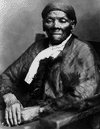
Tubman, Harriet
née Araminta Ross(born c. 1820, Dorchester county, Maryland, U.S.—died March 10, 1913, Auburn, New York) American bondwoman who escaped from slavery in the South to become a leading abolitionist before the American Civil War. She led hundreds of bondsmen to freedom in the North along the route of the Underground Railroad—an elaborate secret network of safe houses organized for that purpose.
Born a slave, Araminta Ross later adopted her mother's first name, Harriet. From early childhood she worked variously as a maid, a nurse, a field hand, a cook, and a woodcutter. About 1844 she married John Tubman, a free black.
In 1849, on the strength of rumours that she was about to be sold, Tubman fled to Philadelphia. In December 1850 she made her way to Baltimore, Maryland, whence she led her sister and two children to freedom. That journey was the first of some 19 increasingly dangerous forays into Maryland in which, over the next decade, she conducted upward of 300 fugitive slaves along the Underground Railroad to Canada. By her extraordinary courage, ingenuity, persistence, and iron discipline, which she enforced upon her charges, Tubman became the railroad's most famous conductor and was known as the “Moses of her people.” Rewards offered by slaveholders for her capture eventually totaled $40,000. Abolitionists, however, celebrated her courage. John Brown, who consulted her about his own plans, referred to her as “General” Tubman. About 1858 she bought a small farm near Auburn, New York, where she placed her aged parents (she had brought them out of Maryland in June 1857) and herself lived thereafter. From 1862 to 1865 she served as a scout and spy, as well as nurse and laundress, for Union forces in South Carolina.
After the Civil War Tubman settled in Auburn and began taking in orphans and the elderly, a practice that eventuated in the Harriet Tubman Home for Indigent Aged Negroes. The home later attracted the support of former abolitionist comrades and of the citizens of Auburn, and it continued in existence for some years after her death. In the late 1860s and again in the late 1890s she applied for a federal pension for her Civil War services. Some 30 years after her service a private bill providing for $20 monthly was passed by Congress.
Copyright © 1994-2005 Encyclopædia Britannica, Inc.

